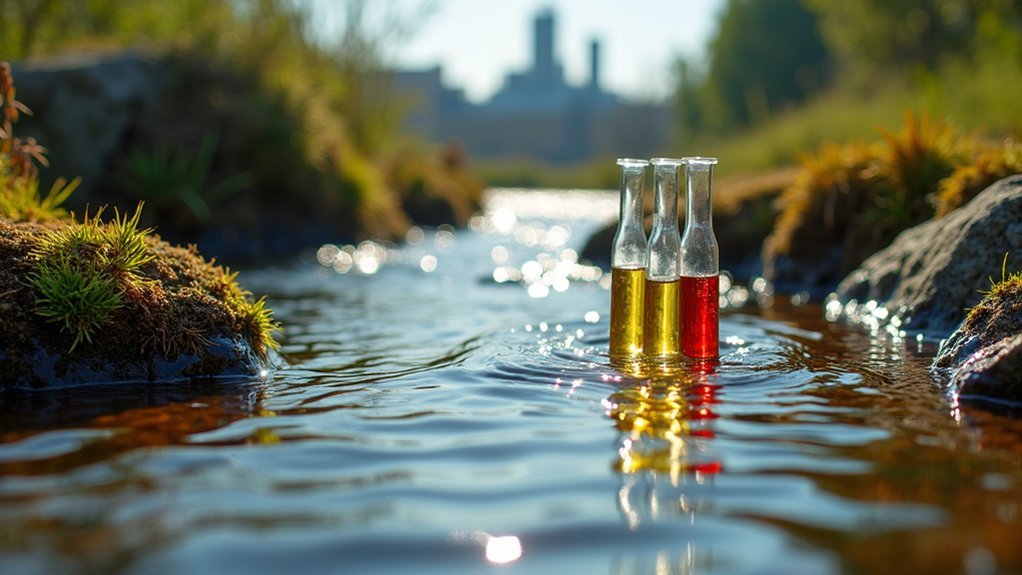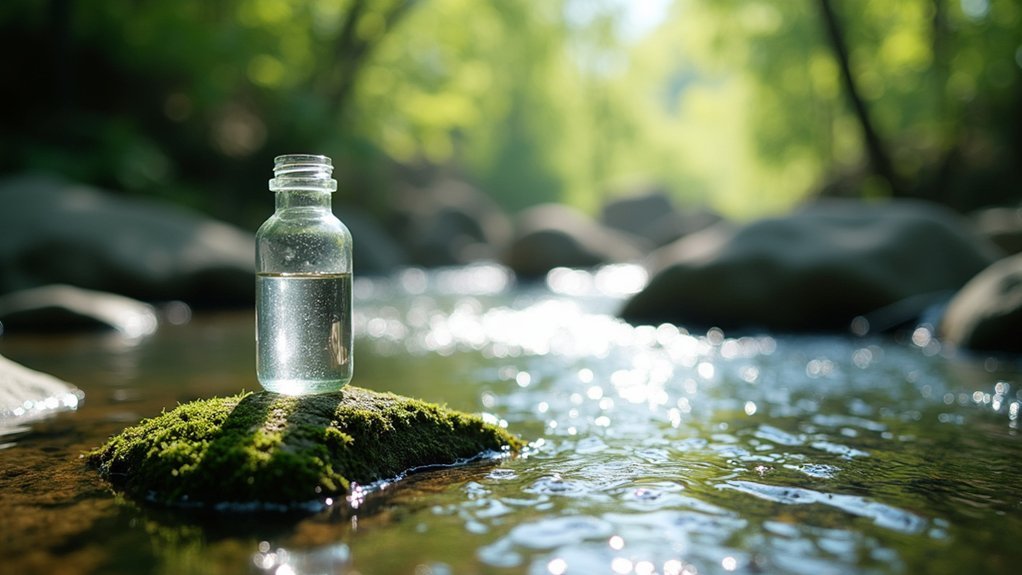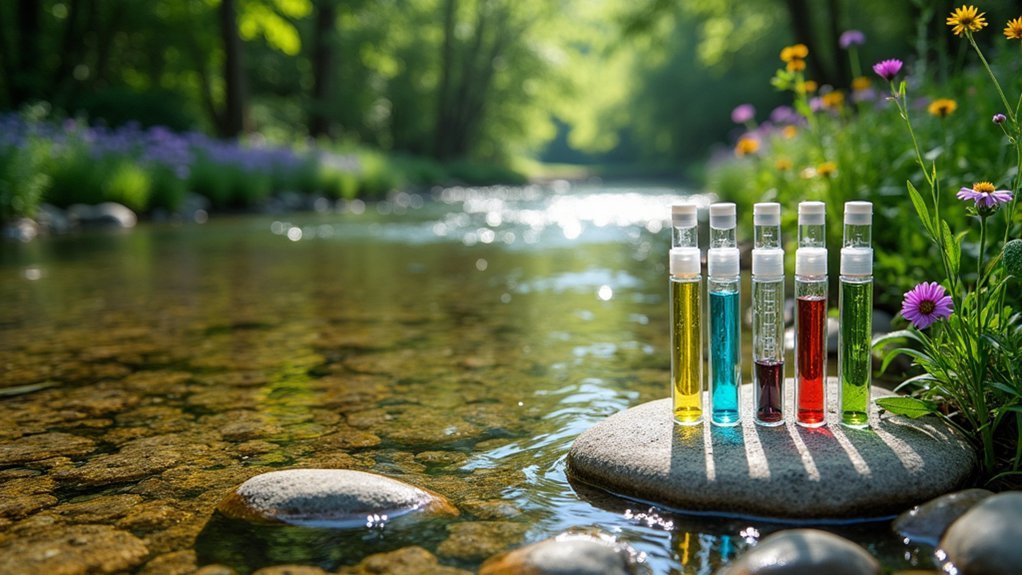Testing your local stream requires simple equipment like water sampling kits, test strips, and protective gear. You'll need to check for common contaminants including heavy metals, bacteria like E. coli, and nutrients that cause algal blooms. Regular monitoring across seasons provides the most accurate picture, as spring runoff and summer heat affect pollution levels differently. Compare your results to EPA standards (like 15 ppb for lead or 235 CFU/100mL for E. coli) to determine if your stream is safe or toxic.
Testing Your Local Stream: Safe or Toxic?

How often do you wonder about what's really flowing through your neighborhood stream? That serene waterway might harbor invisible contaminants like heavy metals, pesticides, and harmful pathogens that pose serious health risks to both humans and aquatic life.
Water quality testing is essential to identify specific pollutants such as E. coli, nitrates, and toxic metals. The Environmental Protection Agency recommends regular monitoring, especially near agricultural or industrial zones where contamination risks are higher.
Regular water quality monitoring isn't optional—it's our vital defense against invisible threats lurking in waters near high-risk zones.
You don't need to be a scientist to make a difference. Community involvement in stream testing initiatives creates valuable data while raising environmental awareness.
Many organizations provide affordable testing kits and resources that enable you to participate in protecting your local ecosystem. By testing your stream, you're taking an active role in safeguarding your community's water resources.
Common Urban Stream Contaminants and Their Sources
Urban streams often contain a complex mixture of pollutants that most residents never see. When you walk beside your local waterway, heavy metals like lead and mercury are likely present, originating from industrial discharges and aging infrastructure in your neighborhood.
Nutrient pollution from fertilizers and pet waste triggers harmful algal blooms, while microbial contamination from fecal matter poses serious health risks following rainfall events.
You'll find toxic chemicals including pesticides and pharmaceuticals entering through agricultural runoff and wastewater systems, disrupting aquatic ecosystems you rely on.
Don't overlook plastics—these break down into microplastics that persist for generations.
Most contaminants reach streams through urban runoff during storms, carrying pollution from streets directly into waterways without treatment. Understanding these sources helps you recognize potential dangers in your local stream.
Essential Equipment for DIY Stream Water Testing

Now that you're aware of what's lurking in urban waterways, you'll need the right tools to test your local stream. A water sampling kit with sterile containers and a cooler is crucial for preserving sample integrity during transport. Bring a portable water quality meter to instantly measure critical parameters like pH, dissolved oxygen, and temperature.
| Equipment | Purpose | Ease of Use |
|---|---|---|
| Water sampling kit | Collect and preserve samples | Moderate |
| Portable water quality meter | Measure key parameters | Easy |
| Test strips | Quick detection of contaminants | Very Easy |
Don't forget test strips for quick assessment of nitrates and phosphates. A field microscope helps identify microorganisms that indicate water health. Always wear protective gear like gloves and goggles when handling samples to guarantee your safety while investigating your stream's condition.
Interpreting Water Clarity and Visual Indicators
When evaluating your local stream, you'll need to distinguish between natural turbidity and actual pollution by checking if cloudy water clears after rainfall or remains consistently murky.
Certain water colors provide immediate warning signs—bright green suggests algal blooms from nutrient runoff, while unusual red, orange, or chemical-like hues often indicate industrial contamination.
Don't overlook films on the water's surface, as rainbow sheens typically reveal petroleum products while white foamy substances may signal detergents or natural organic decomposition.
Turbidity Versus Pollution
Looking at a stream can tell you much about its health, but distinguishing between natural turbidity and actual pollution requires careful observation.
When turbidity exceeds 1 NTU, it may indicate compromised water quality that threatens aquatic life.
Don't be fooled by appearances alone. Clear water might still harbor invisible contaminants like heavy metals or pathogens that pose serious health risks.
Conversely, cloudy water after rainfall might simply reflect natural soil erosion rather than dangerous pollution.
Watch for telling signs: unusual colors, strong odors, floating debris, or oil slicks often signal chemical runoff.
Track turbidity changes over time—consistent cloudiness warrants investigation.
If you notice sudden increases following rain events, this could indicate harmful runoff entering your stream, affecting both water quality and ecosystem health.
Color Signals Danger
Despite what many believe, water color provides one of the most immediate and reliable indicators of stream health. When you're examining your local stream, pay close attention to any unusual colors. Clear water typically suggests safety, while murky, green, or brown water often indicates contamination from pollutants or harmful algal blooms.
Watch for floating debris, oil slicks, or sudden changes in water clarity, especially after rainfall. These visual cues suggest increased runoff carrying toxins that require immediate testing.
If you detect foul odors resembling sewage or rotten eggs, you're likely encountering bacterial contamination that poses significant health risks.
The presence of dead fish or other aquatic life is perhaps the most alarming signal – it indicates severe pollution levels that make the water toxic not just for wildlife but potentially for human contact as well.
Surface Film Analysis
A thin, revealing layer on your stream's surface tells an important story about water quality. These surface films often indicate the presence of pollutants that might not be immediately obvious. When you're examining your local stream, pay attention to visual indicators that signal potential health risks.
| Surface Appearance | What It Means | Action Needed |
|---|---|---|
| Clear, film-free | Likely low contamination | Regular monitoring |
| Iridescent sheen | Oil or chemical pollutants | Report to authorities |
| Foamy or scummy | Organic matter breakdown | Test for bacteria |
Measuring Ph Levels and What They Reveal About Stream Health
Water's pH level serves as a critical indicator of your local stream's overall health. By testing pH levels, you'll discover whether your stream falls within the ideal 6.5 to 8.5 range that supports diverse aquatic life.
When pH drops below 6, it signals increased acidity that can harm fish and other organisms. Regular monitoring helps you identify potential pollution sources affecting your waterway.
Industrial discharges and agricultural runoff often alter pH balance, revealing hidden contamination issues. Watch for sudden changes that might indicate ecological disturbances like algal blooms or heavy metal presence.
You can conduct pH testing using simple, affordable test kits or digital probes available at most outdoor supply stores. These measurements provide valuable data to assess whether your stream remains healthy or requires conservation intervention.
Testing for Heavy Metals in Urban Waterways

Urban streams often harbor invisible threats in the form of heavy metals that pose serious risks to both ecosystem and human health. Lead, mercury, and cadmium from industrial runoff and aging infrastructure contaminate these waterways at alarming rates.
When testing your local stream, collect water samples for analysis using methods like atomic absorption spectroscopy. Compare results to EPA standards—remember that lead shouldn't exceed 15 parts per billion in drinking water.
The health risks associated with heavy metal exposure include neurological damage and developmental issues, with children and pregnant women being particularly vulnerable.
While local environmental agencies conduct monitoring, you shouldn't rely solely on their efforts. Independent testing provides you with essential information about potential contamination in your community's waterways, empowering you to advocate for cleaner water.
Detecting Agricultural Runoff and Chemical Pollutants
You'll need to watch for telltale signs of agricultural runoff in your stream tests, including elevated nitrogen and phosphorus levels that often indicate fertilizer contamination.
Simple chemical test strips can reveal pesticide presence, while laboratory analysis provides more precise measurements of specific agricultural chemicals like atrazine or glyphosate.
Regular monitoring across different seasons helps establish baseline conditions and detect chemical signature patterns that distinguish agricultural pollution from other contaminants.
Runoff Detection Methods
Detecting agricultural runoff and chemical pollutants in your local stream requires both observation skills and scientific testing. Start by visually inspecting the water for discoloration, unusual odors, or foam on the surface—these are telltale signs that contaminants are present.
For more definitive results, water sampling followed by laboratory analysis is essential. Techniques like gas chromatography can identify and quantify toxic substances including heavy metals, pesticides, and industrial solvents.
Schedule your sampling strategically by monitoring rainfall events, as runoff typically increases during and immediately after precipitation.
Understanding nearby land use patterns will help you anticipate potential pollution sources. Agricultural areas may contribute fertilizers and pesticides, while industrial zones might introduce chemical waste.
This knowledge allows you to develop a targeted testing approach for your stream's specific risks.
Identifying Chemical Signatures
Chemical signatures in stream water tell a revealing story about potential pollution sources affecting your local watershed.
When testing for agricultural runoff, look specifically for elevated levels of nitrates and phosphates, which often trigger harmful algal blooms that deplete oxygen and harm aquatic life.
Water testing kits designed to detect chemical pollutants can identify residual pesticides and herbicides that have entered your stream.
Compare your results against EPA maximum contaminant levels to determine if water quality meets safety standards.
Don't forget to monitor for heavy metals like lead and copper, which can originate from agricultural practices and pose significant risks to both humans and wildlife.
Bacterial Testing Methods for Recreational Water Safety

When you're planning to swim in your local stream, knowing what's in the water can literally save you from illness. Bacterial testing methods help identify coliform bacteria, especially E. coli, which indicate potential health risks from contamination.
You can guarantee water safety through these approaches:
- Membrane filtration – A precise technique that filters water to trap and count bacteria.
- Multiple-tube fermentation – Tests water samples in tubes to determine bacteria concentration.
- DIY testing kits – Provide quick results you can interpret at home.
- Laboratory analysis – For thorough, certified results.
Seasonal Variations in Stream Contamination Levels
Beyond bacterial testing methods, you'll need to contemplate when you test your stream throughout the year. Seasonal variations dramatically affect contaminant levels in waterways, creating a constantly changing profile of potential pollutants.
| Season | Primary Concerns |
|---|---|
| Spring | Heavy rainfall increases runoff, elevating fecal coliform levels |
| Summer | Higher temperatures promote toxic algal blooms in nutrient-rich waters |
| Fall | Agricultural activities introduce pesticides and fertilizer runoff |
| Winter | Ice cover traps pollutants, delaying decomposition |
| Year-round | Land use changes affect contaminant types and concentrations |
Regular seasonal testing provides the most thorough picture of your stream's health. If you're limited to testing once yearly, spring typically offers the "worst-case scenario" with its high runoff potential, making it ideal for identifying maximum contamination levels.
Mapping Pollution Hotspots in Your Local Watershed

You can locate pollution sources in your watershed using EPA's Surf Your Watershed tool, which reveals industrial discharges, agricultural runoff, and urban contaminants affecting your local streams.
Joining community monitoring networks will connect you with neighbors who regularly sample water and document seasonal contamination patterns throughout the year.
Identifying Discharge Sources
Understanding where pollution enters your local stream is critical for effective watershed protection. By identifying discharge sources, you'll gain insight into the specific pollutants affecting water quality in your area.
Regular monitoring and targeted water quality testing can reveal contamination patterns linked to particular sources.
To identify discharge sources in your watershed:
- Map industrial facilities, wastewater treatment plants, and agricultural operations near your stream.
- Note urban areas where stormwater runoff may carry contaminants from roads and buildings.
- Collect water samples upstream and downstream of suspected discharge points to detect changes in contamination levels.
- Engage your community in reporting unusual water conditions, like discoloration or odors, which often indicate nearby discharge sources.
GIS technology can help visualize these pollution hotspots for more effective intervention planning.
Community Monitoring Networks
The power of local knowledge transforms stream monitoring when residents join forces through community monitoring networks. By conducting regular water quality tests, you'll track pollutants like heavy metals, bacteria, and nutrients in your watershed.
This citizen-science methodology allows you to create detailed maps highlighting contamination hotspots that deserve immediate attention. Your participation goes beyond collecting data—it builds environmental stewardship and raises community awareness about pollution impacts on ecosystem and human health.
Connect with local environmental organizations, universities, or government agencies to access training, equipment, and laboratory testing resources to strengthen your efforts. These collaborative networks convert individual concern into powerful collective action, transforming scattered observations into thorough pollution maps that drive targeted interventions and protect your local waterways.
Tracking Seasonal Variations
Streams tell different stories as seasons change, revealing pollution patterns that might remain hidden during single-point testing. By conducting water quality tests throughout the year, you'll identify contamination hotspots in your watershed and understand how pollutant levels fluctuate with seasonal variations.
To effectively track these changes:
- Test consistently during different seasons, especially after spring and fall rainstorms when runoff increases.
- Use GIS technology to visualize how pollutants distribute across your watershed over time.
- Pay special attention to areas near agricultural fields or urban developments where seasonal changes impact contamination most.
- Partner with other community members for regular monitoring, expanding your data collection capabilities.
This systematic approach helps you target cleanup efforts where they're most needed and engage stakeholders in protecting your local waterways year-round.
Comparing Your Results to Environmental Safety Standards
Once you've collected your stream water test results, comparing them to established environmental safety standards helps you determine if your local waterway poses any health risks.
Your testing kit likely measures various contaminants that environmental agencies regulate. For instance, if your water quality analysis shows lead levels exceeding the EPA's 15 parts per billion threshold, your stream may require intervention.
Pay particular attention to microbial contamination markers like E. coli, where readings above 235 CFU per 100mL indicate unsafe recreational water.
PFAS and other emerging contaminants also have established safety thresholds worth checking. Regular comparison against these benchmarks helps you identify potential health concerns before they impact your community and local ecosystem.
This vigilance guarantees that everyone can safely enjoy local waterways while protecting environmental health.
Reporting Hazardous Findings to Local Authorities
When hazardous contaminants appear in your test results, you'll need to act quickly by reporting your findings to proper authorities. Effective reporting guarantees that contamination issues receive prompt attention and appropriate remediation.
Follow these steps when contacting local authorities:
- Document everything thoroughly with photographs and detailed notes about the location, time, and nature of the contamination.
- Contact your local environmental protection agency or water quality authority with your hazardous findings.
- Share your water quality test results, including specific contaminants detected and their concentrations.
- Follow up on your report to confirm action is taken and inquire about any public health advisories.
Understanding local water pollution laws will strengthen your communication with authorities and help protect your community's water resources.
Frequently Asked Questions
How to Check if Your Drinking Water Is Safe?
You should test your drinking water with certified labs, review your Consumer Confidence Report, and consider home testing kits like Tap Score that analyze contaminants including lead, PFAS, and heavy metals.
How Can I Test My Water Quality Myself?
You can test your water quality with DIY kits ($20+) that measure pH, chlorine, and hardness. For thorough results, consider send-away services like Tap Score ($160+) that detect over 100 contaminants including metals.
How to Test Stream Water for Drinking?
You'll need to collect a midstream sample, send it to a professional laboratory for contaminant testing, and compare results against EPA standards. Don't rely solely on DIY kits for drinking water safety assessment.
How to Know if River Water Is Clean?
You'll need to check water clarity, use testing kits for contaminants like bacteria and chemicals, and consult local water quality reports. Don't rely solely on appearance—clean-looking water can still harbor harmful substances.
In Summary
You've taken the first step toward becoming a water quality advocate in your community. By monitoring your local stream, you're not just collecting data—you're protecting an ecosystem that affects everyone. Don't keep your findings to yourself. Share results, build awareness, and partner with local organizations. Your consistent testing efforts can lead to meaningful environmental change right in your backyard.




Leave a Reply